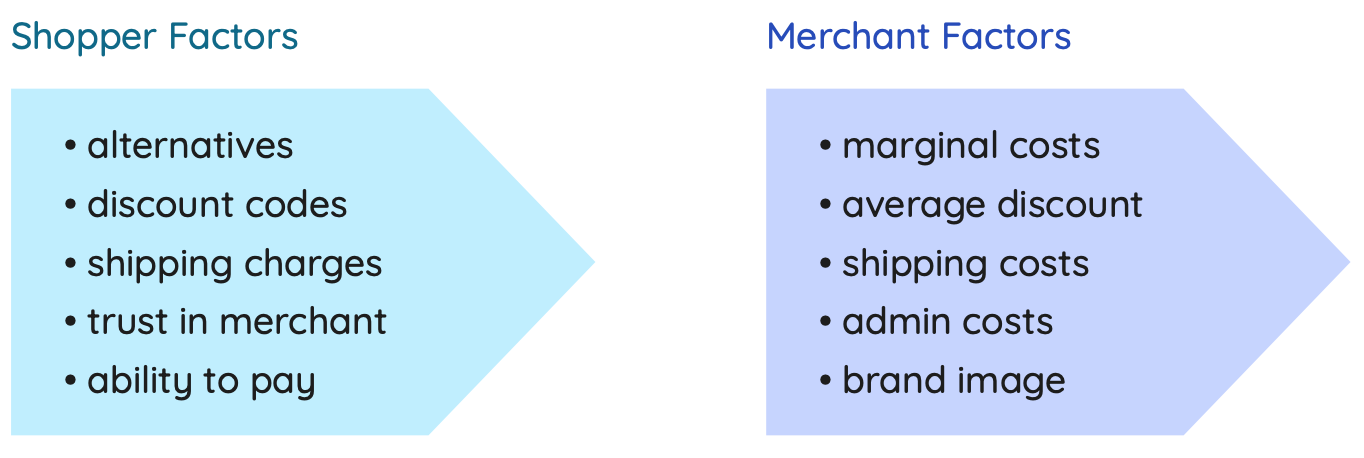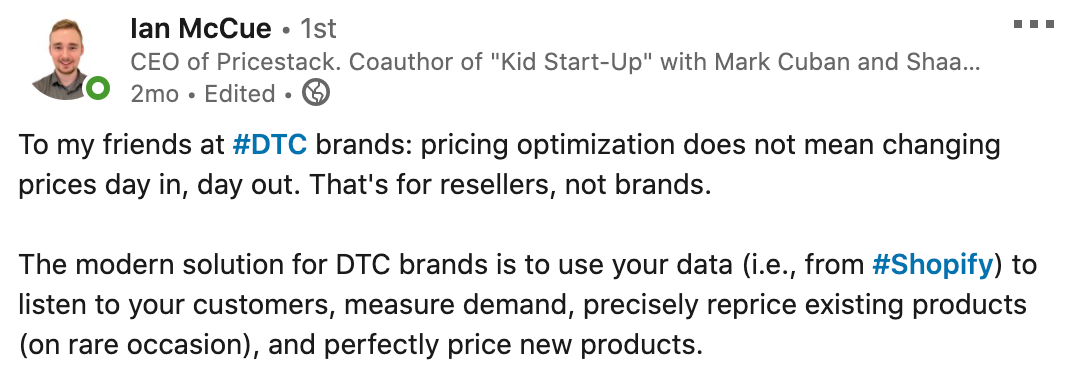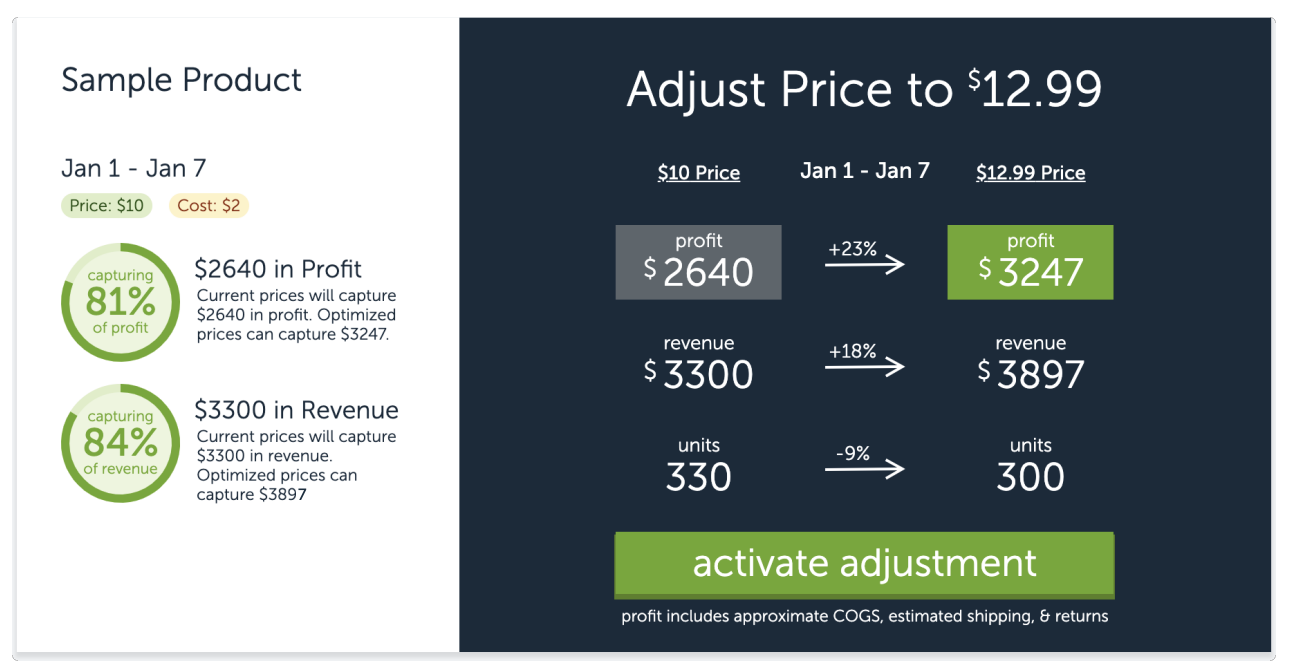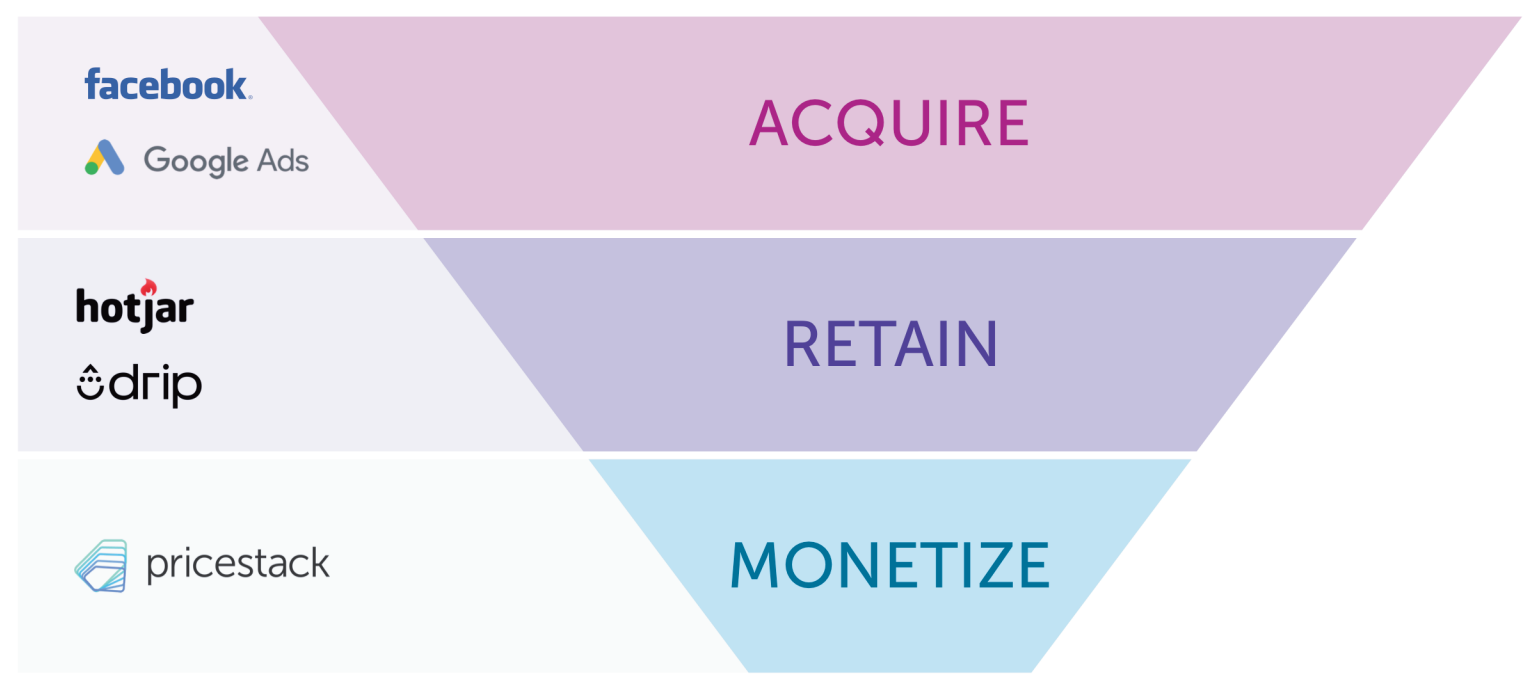Beginners Guide to Pricing Optimization for eCommerce

How do brands determine what their products should cost? It can be a tricky balance of supply chain, revenue goals, competition, and numerous other factors that directly affect business performance, but the most important part is understanding what your customers want to pay.
We created this guide to help eCommerce teams better understand pricing and how you can intelligently determine the ideal prices for your products. Why is this such a big deal? Well, because pricing is everything. It affects cart abandonment rate, your customers’ first impressions, and even their entire shopping experience.
In this article, you can expect to learn the basics of pricing optimization, such as:
- What is it?
- How does it work?
- Why should I care about it?
Most importantly of all, you’ll find out how pricing optimization is changing to become more powerful and easier to implement than ever for eCommerce brands of all sizes. Let’s get started…
What is pricing optimization?
Price optimization is the process of using data analysis to understand how customers will react to different prices for any given product, with the goal of determining the price that maximizes revenue, profit, or a combination of the two.

Just a few examples of factors that can determine pricing for eCommerce merchants.
In other words, price optimization is the process of finding the most optimal price for a product that will yield the best results. Behavioral price optimization is a type of price optimization that utilizes merchants’ on-site sales data to analyze consumer behavior (more on this later).
Why is it important to eCommerce brands?
Price optimization is the key to sustaining high levels of growth for ecommerce brands. It is so important because we do not live in a static world. Everything in our world is in motion, constantly changing. Consumers’ wants, needs, tastes, preferences, and budgets are always changing. What’s “hot” in different consumer markets is always changing and evolving over time. Tax policy, trade policy, regulations are always changing your costs, too.
Digital ads are growing increasingly competitive and customer acquisition costs are rising, necessitating the need for higher conversion rates and customer lifetime values to balance them out.
Most merchants adapt too late to make a meaningful impact. This is why it is so imperative that ecommerce brands have the tools necessary to monitor the ever-changing world and execute the necessary pricing adjustments to facilitate year-over-year growth by reducing customer acquisition costs and increasing customer value. The key is being able to detect trends in the changing environment as they begin to occur so that you can capitalize on them to the fullest extent.
How does pricing optimization work?
Pricing is one of the most difficult challenges every merchant has to face, and each one has a different process that is as unique as their business. While this may be the case, there are still common practices (AI-driven analysis, constant adaptation) that work across the board.
We’ve distilled these into a simple three-step process automated by Pricestack:
- Gather data on each product’s historical sales volumes in the context of overall store performance and trends, the product’s list and sale prices, and the preponderance of promotional discount codes. Leading vendors seamlessly integrate with your historical data.
- Analyze these data points to discern the controllable effects of price changes and discounts from the uncontrollable effects of trends and seasonality. Leading vendors use machine learning to analyze your data and provide visual insights.
- Calculate goal-achieving prices based on the desired mix of profit margins and sales volumes. Leading vendors turn numbers into words, making your pricing decisions easy. Pricing optimization is a complex process. The best vendors offer comprehensive software that handles the process behind the scenes for you, enabling you to easily make informed pricing decisions.
Pricing can be really hard, but with the right combination of behavioral analysis and automation, it can also turn out to be surprisingly easy.
Is pricing optimization different from a/b price testing?
Price optimization is completely different from A/B price testing. A/B price testing is a trial and error process that requires an extremely large amount of data, time, and careful analysis to cut through the noise. It’s often confusing and not very friendly to shoppers.

Price optimization is not price testing. In fact, no testing of prices is required for price optimization, especially not behavorial price optimization. The primary goal of behavioral price optimization is to analyze and interpret consumer behavior so that you can discover optimal prices quickly and accurately without needing to actively test prices.
This means that price optimization can begin immediately, whereas A/B price testing can take months to yield any meaningful results at all.
What about price matching?
Price optimization is also very different from price matching. There are so many merchants that think they must obsessively monitor and compete with competitors’ prices to satisfy price sensitive customers. Here’s the thing: if your prices aren’t competitive enough, your customers will tell you through their behavior.
Competitor pricing is an implicit part of consumer behavior, especially for those shoppers who are constantly looking for the best deal. However, unique and differentiated brands have unique and differentiated products with unique and differentiated customers.
You cannot truly “price match” against a unique brand with unique products. Unique brands have unique opportunities when it comes to formulating their own pricing strategy. In other words, the level of competition that your brand must sustain is determined by your customers and your customers alone.
Measuring success in pricing optimization
Measuring success with price optimization really depends on a merchant’s individual goals. Optimal price can be used as both an objective and subjective term, depending on context. There is, in fact, a truly optimal price for each and every product. However, “optimal” will mean something else depending on your specific goals.

Forecast of potential results after running pricing experiments.
The Two Types of Price Optimization
Optimizing for Revenue
Revenue optimization is a great optimization strategy for high-growth SMBs. When a brand is still small, experiencing extreme growth, and fighting the mega-giants in their space, their main focus should be moving products as quickly as possible. If they have a unique product with differentiating features and a great brand image, they need more people to own and experience their products. To achieve this, profit cannot be at the forefront of the growth strategy. Revenue optimization will empower brands to sell more products, build their awareness, and contribute to sustaining high levels of growth.
Optimizing for Profit
Profit optimization is the route that established brands need to travel when they’ve created large funnels and have an established customer base that knows and loves their products. At this stage, improving the unit economics – customer lifetime value and customer acquisition costs – is key to sustainability at scale. Profit optimization is also great for brands that have had historically thin margins. As consumer markets fluctuate, certain brands may find themselves in positions where they cannot currently move enough product to justify their razor thin margins, and they have to adapt. Whatever the exact strategy may be, what is so great about optimizing prices for profit is that the extra profit goes straight to the bottom line, immediately. There are no product development costs or delays. A merchant can immediately adjust a product’s price and put the resulting profits to good use.
Smoke Cartel Case Study
Pricestack began to work with SmokeCartel.com in mid-2019. After analyzing their historical sales data, we helped them quickly determine that a large number of their top selling products were overpriced. Some of their customers were more price sensitive than they previously thought. After deploying their data-driven price adjustments suggested by Pricestack’s AI, SmokeCartel.com saw an increase of +175% in revenue per-visitor and an increase in conversions.

Example of a pricing adjustment done by Pricestack for Smoke Cartel.
A common question that arises when discussing the successes of AI-driven behavioral price optimization is, “How do you differentiate gains due to price optimization from other successful strategies and campaigns that the merchant may be executing simultaneously?” The answer is simple: all metrics must be viewed on a per-visitor level. In the case of SmokeCartel.com it was very important to measure success on a per-visitor level so that we could accurately differentiate the success they had from their price optimization from other growth efforts occurring within the organization.
Why we built Pricestack
We built Pricestack to empower DTC merchants to optimize their prices and better serve their customers in the ever-changing world.
Pricestack utilizes AI-driven behavioral price optimization by analyzing how shoppers react to prices, and how shoppers react to prices of products that have highly correlated demand.
It’s funny really how many DTC eCommerce merchants claim to be “customer-driven.” They spend a great deal of time and money to build brands that take a “customer-first” approach to product design, functionality, ease of use, UI, UX, customer service, etc. However, when it comes to forming their pricing strategy, the first thing they turn to is their internal data.

Merchants might factor in R&D costs, COGS, shipping costs – all of the costs associated with bringing their product to market. Here’s the cold hard truth: customers don’t have access to any of that information, and frankly, they don’t care!
Every single other aspect of their business strategy may be customer driven, but they come up short in their pricing strategy. In reality, the customer should be at the forefront of every strategy, including price, because they are the individuals who matter most. Your customers are the ones buying your product – not you, and not your competitors.
We built Pricestack because we believe that price is a form of conversation between customers and merchants. The problem was that no merchant had the tools necessary to hear this type of feedback. Customers were talking, yet their voices went ignored. Pricestack gives merchants the tools not only to listen to consumer behavior, but to interpret the conversation, turning data into prices that both satisfy their customers and their bottom line.
—
Brecker Brees is Co-Founder of Pricestack and Chief Service Officer. He has a background in Finance and Economics, studying behavioral economics at the Economic Science Institute at Chapman University in Orange, California.
Brecker is most passionate about one of the greatest tools in the world of business: Price.
Connect with him on LinkedIn or visit the Pricestack website for more info on what his team is working on.



